Reviewer's Note: This is a review of new 1x18650-sized EDC light by Lumapower, the Encore. For a comparison to the original 1xRCR123A Incendio, please see my detailed review of that light. The Encore was provided by Ricky at LP for review.
UPDATE April 5, 2009: Lumapower has released a TurboForce head for their Encore and Connexion lights, offering greater throw than the standard shallow reflector on these models. I have have provided pics below.
This light is Lumapower's newest offering in the small EDC (every day carry) space, following up on the 1xRCR/CR123A Incendio and 1xAA/14500 Connexion. The Encore uses a similar build, but can take 1x18650, 2xRCR or 2xCR123A. All three lights share a similarly sized head/reflector, and similar build features.
Note that all members of the Lumapower EDC line have recently undergone a revision. See the end of my review for a discussion of the differences between the new V2 versions (including the Encore) and the earlier V1 Incendio/Connexion.
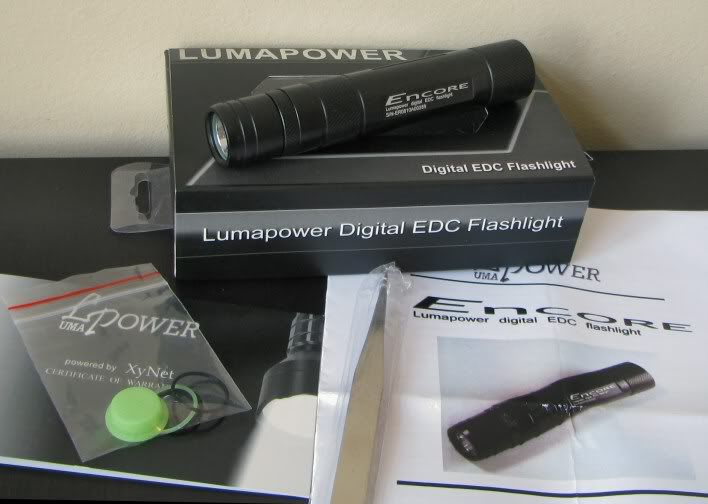
As you can see, the light comes with an attached built-in clip (now removable), extra o-rings and GITD tailcap button, instruction manual, warranty card, and a pair of tweezers (to allow you to unscrew the switch retaining ring). The tweezers are similar to the ones you'd find on the deal sites - not very high quality, but are a nice touch to include.
For scale reference, below is a pic of the Encore and the first generation Incendio and Connexion lights, with their respective batteries.
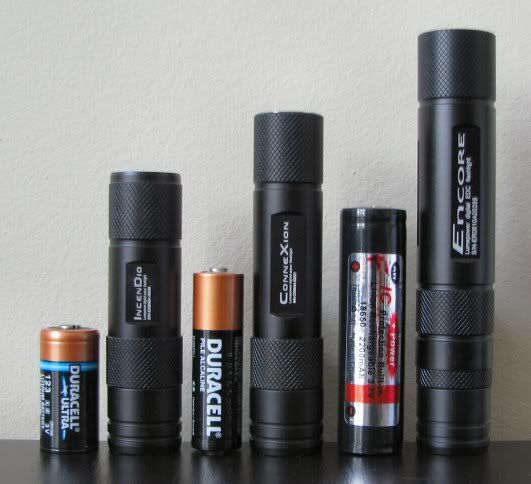
Scroll down for a comparison pic to other members in the 1x18650 class.
Overall length: 114.9mm
Width: 21.6mm (tail), 20.5mm (head)
Battery tube wall thickness: ~1.6mm
Weight: 42.5g (without battery)
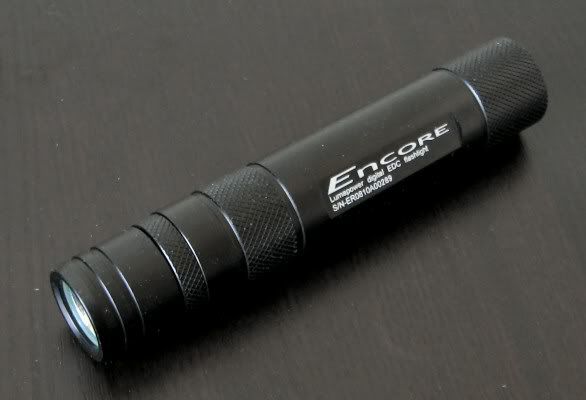
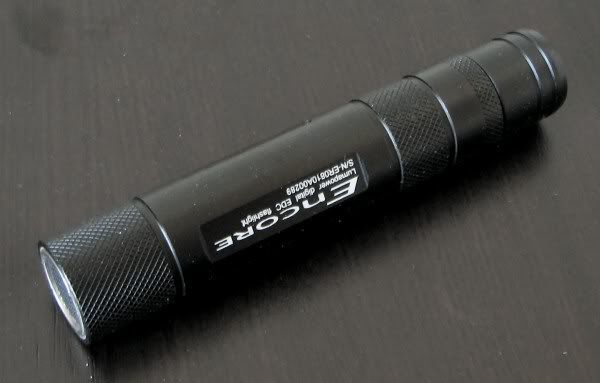
The other EDC series of lights from Lumapower only have type II black anodizing, although the Encore is supposed to be hard anodized (i.e. HA, aka type III). Unfortunately, my Encore has a chip on the tail near the removable pocket clip (see below) - otherwise, anodizing was good on my sample. Lettering is clear and sharp, as with all Lumapower lights (which is among the finest lettering I've ever seen :kiss . Overall body is quite smooth, so the removable clip helps with grip and anti-roll. Clip is for bezel-down carry only.
. Overall body is quite smooth, so the removable clip helps with grip and anti-roll. Clip is for bezel-down carry only.
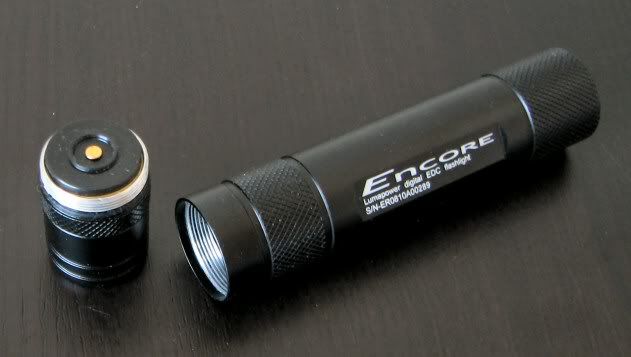
The black disc in the head has been updated on all V2 lights to have a ridge around the battery contact point. This is the "reverse polarity protection" feature – it's entirely mechanical, as the flat-end of the battery would be prevented from touching the contact point. But this also means that none of the older flat-top 18650 batteries will work without modification (i.e. you need to use the newer button top variety). :shakehead
Like the Incendio and Connexion, screw threads are fairly limited and narrow on the Encore. Screw thread action feels a little rougher on my Encore specimen that it does on either my Incendio or Connexion. Threads are not anodized on any of these lights, so no lock-out is possible.

Tailcap is a forward clicky, covered with a black switch cover (GITD included in the package). The original V1 Incendio/Connexion came with only a GITD, so good to have the option now. Switch is recessed so that the unit can now tailstand when the light is on or off (V1 lights could only tailstand reliably when activated). As a result, I find this switch harder to activate, since your finger needs to go deeper into the light.
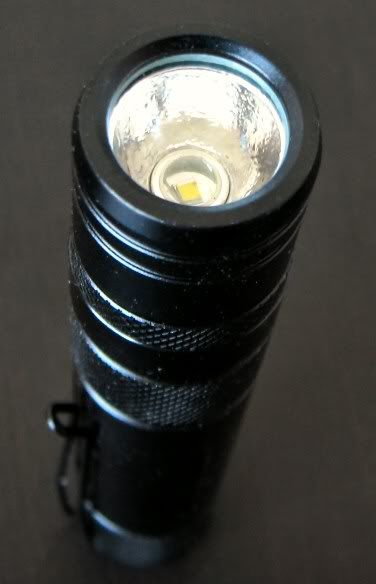
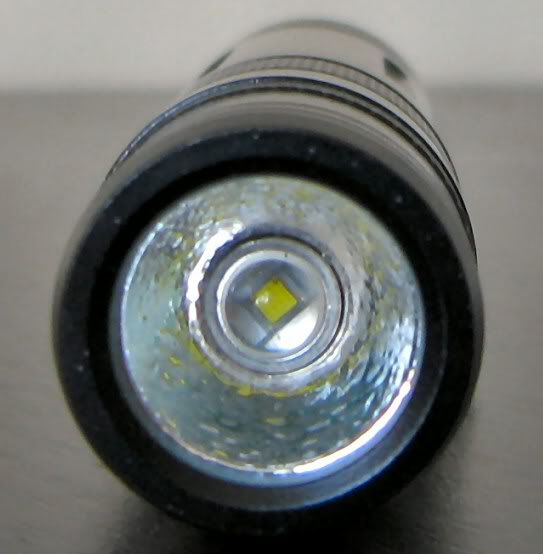
The head unit is basically unchanged from the Incendio/Connexion. They use the same size reflector, lens, and o-ring (which is a rather pale GITD type).
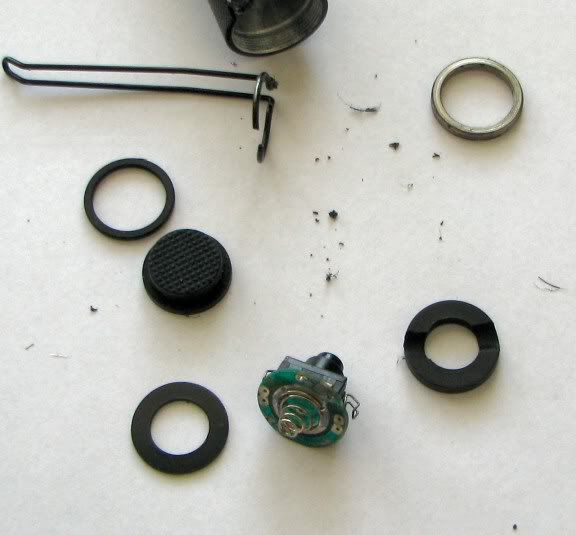
One of the new features of the V2 lights is the ability to access the tail switch and remove the clip. When I went to do this, a number of bits of black debris fell out of the light. :thinking: The o-ring was intact, so I think these are from the foam spacers placed on either side of the switch. The switch has some metal clips along its edge, and I suspect these chewed into the foam spacers when the light was assembled. Doesn't affect function, and the parts are easily accessible (although again, I found the screw threads for the retaining ring rather rough).
UPDATE April 5, 2009: Available as an upgrade to the Encore is a TurboForce head with larger reflector for more throw. Below are some comparison pics with the new reflector.
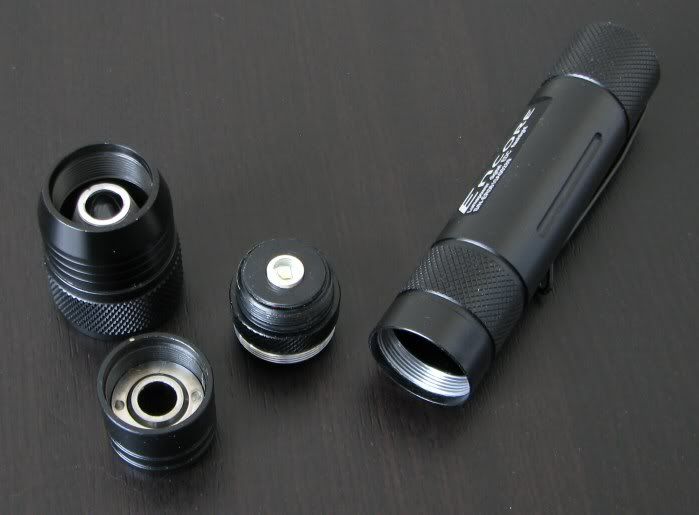
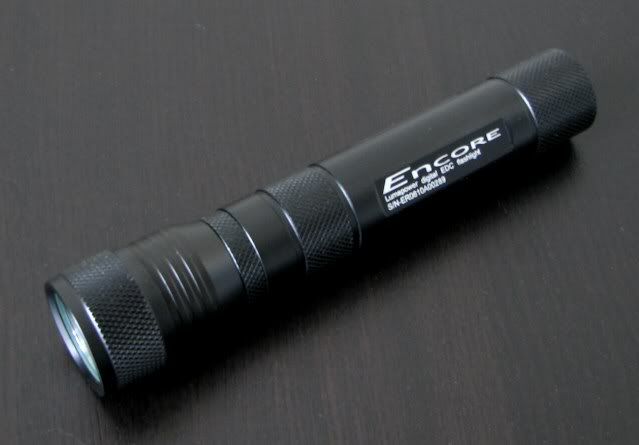
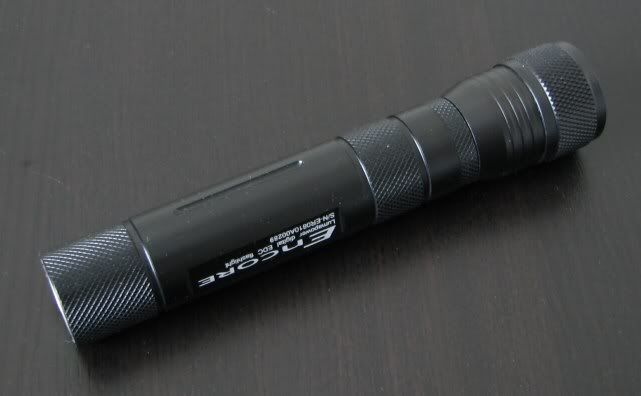
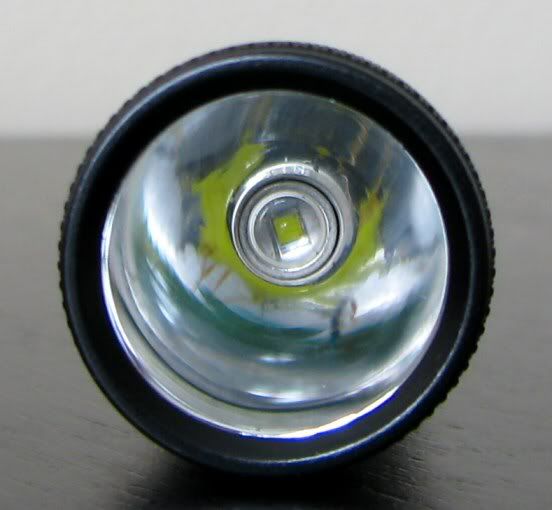
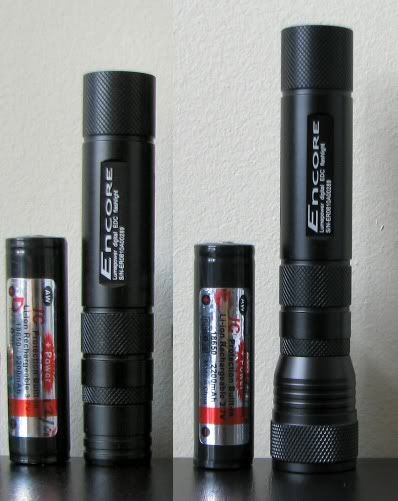
For the beamshots below, I've used the Connexion X2 with standard head as a comparator (running on 14500). Beam pattern and overall output is similar to the Encore standard head on 18650.
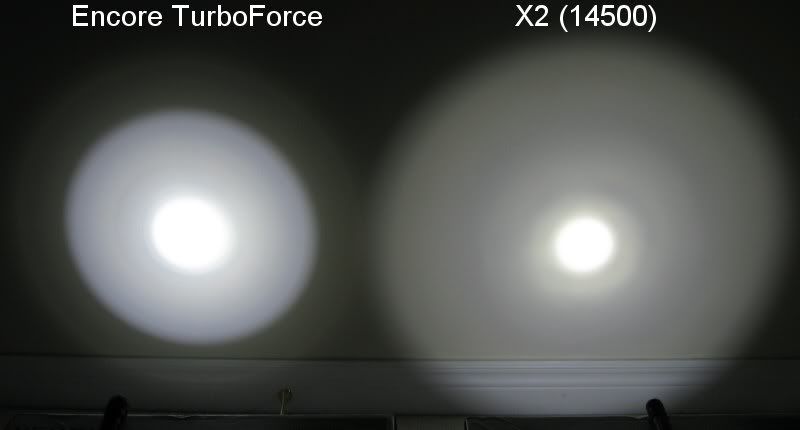
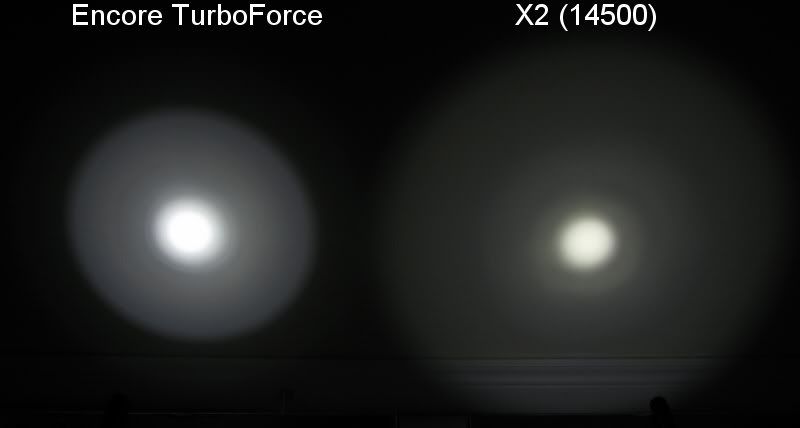
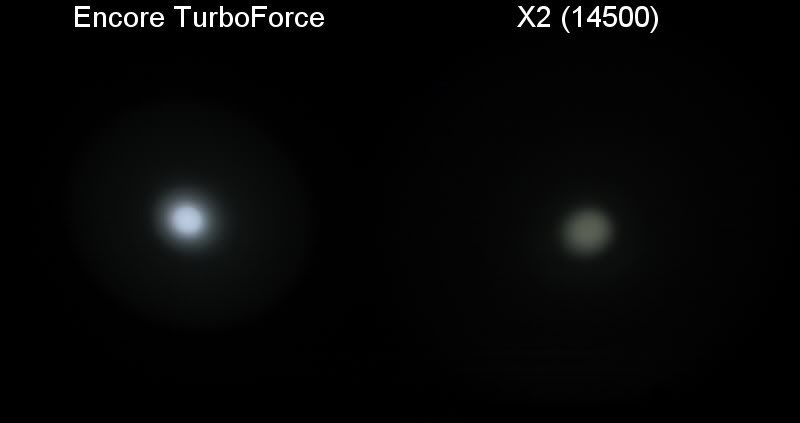
As you can see, the new TurboForce head has a much narrower spillbeam and much brighter hotspot. Overall output and runtimes are unaltered, as the same emitter/circuit is used (i.e. it is just the reflector assembly that is new). The summary table further down in this review has been updated below with additional lux numbers.
User Interface

From left to right, CR123A, 18650 battery, Encore, JetBeam Jet-III PRO ST, Olight T20, Romisen RC-M4, Solarforce T7. Note that the Olight T20 and Solarforce T7 cannot take 18650 or protected 17670 batteries, since the internal diameter is too narrow.
As you can see, the Encore is the smallest light of this class in my collection.
Beamshots:
Comparison taken at ~0.5 meters from a wall, to show you the different overall spill patterns. All lights are running on AW protected 18650.
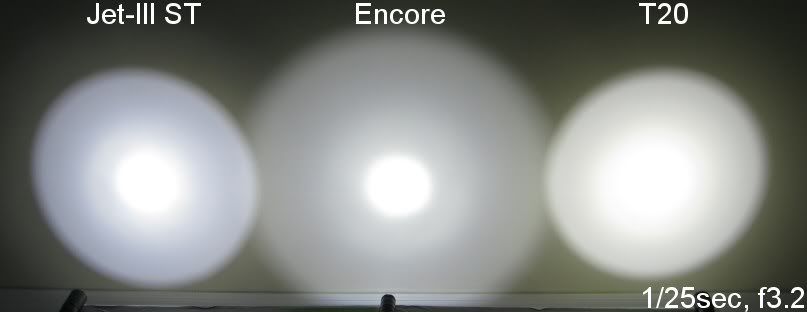
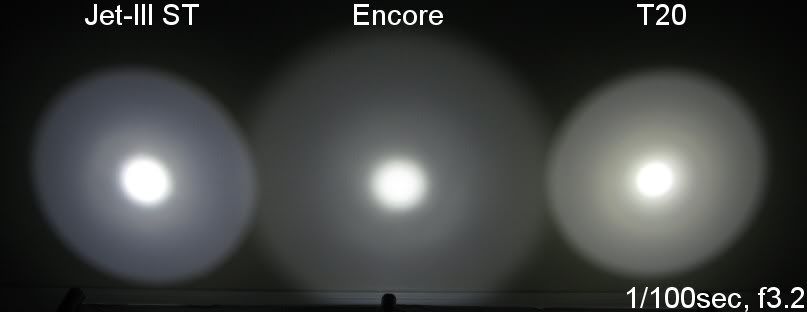
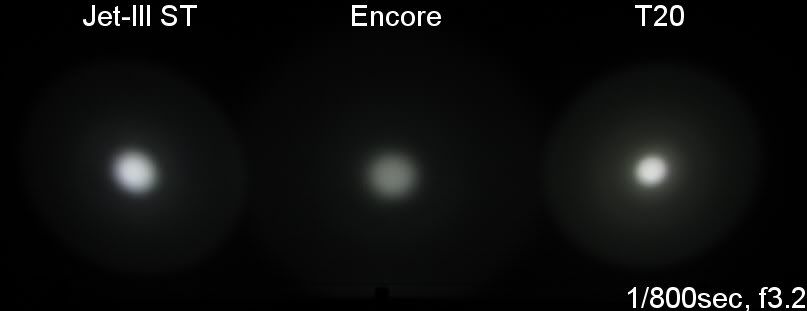
As you can see, the Encore is definitely not a thrower. But the light has a very nice beam (identical to the Incendio/Connexion, since the head is the same). In fact, its one of the smoothest beams I've seen for a Cree light :kiss:. Spillbeam is wider than most lights, with a smooth transition from spot to spill.
Testing Method: All my output numbers are relative for my home-made light box setup, a la Quickbeam's FR.com method. My relative overall output numbers are typically similar to his, although generally a little lower. You can directly compare all my review graphs - i.e. an output value of "10" in one graph is the same as "10" in another.
Output, Throw and Runtime Comparisons
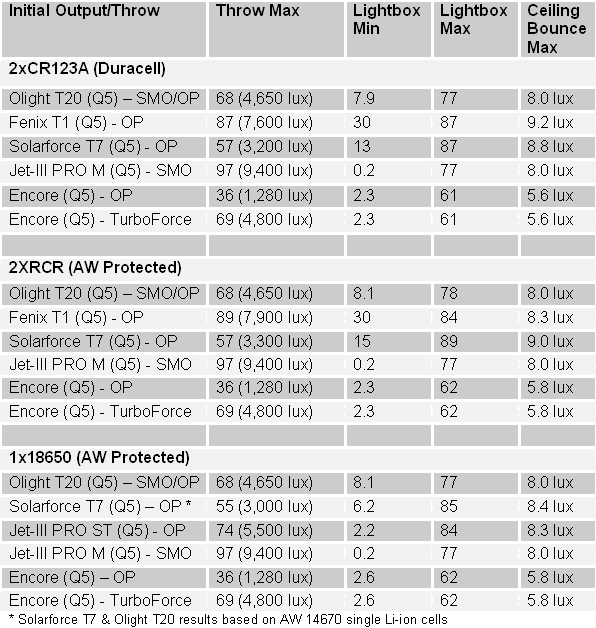
As you can see, the Encore is not a heavy thrower. Overall output is also not as high as the typical 18650-sized lights, but that's appropriate given the smaller body of the Encore (with its more limited heat-sinking).
Runtimes:
To allow you to compare output levels and runtimes to the original Incendio, I've added that light to my 18650-class comparisons below.
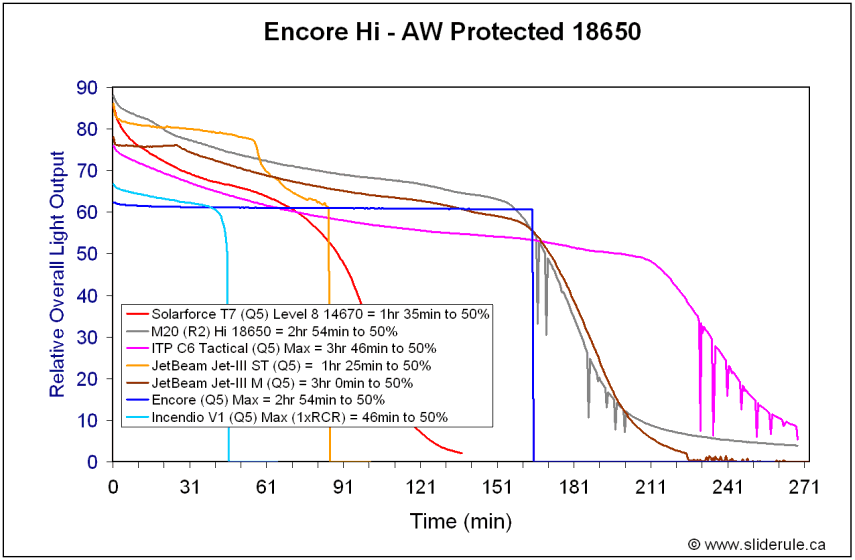
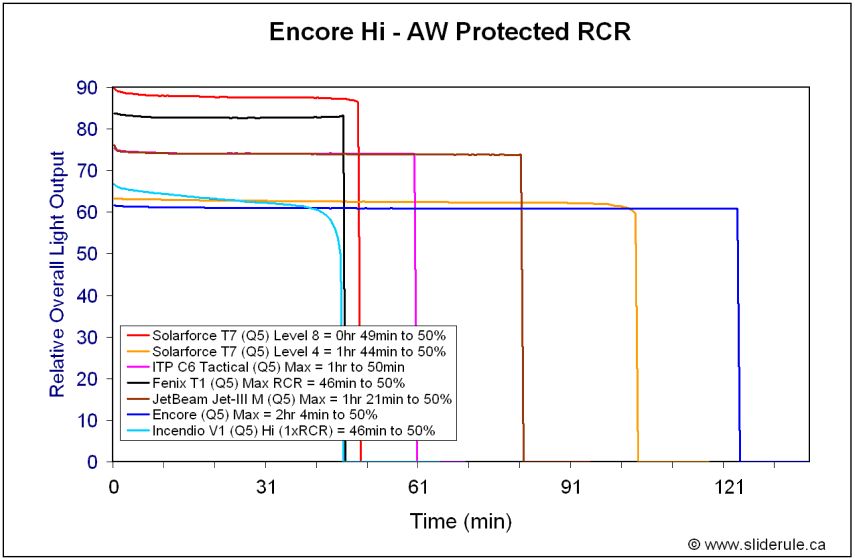
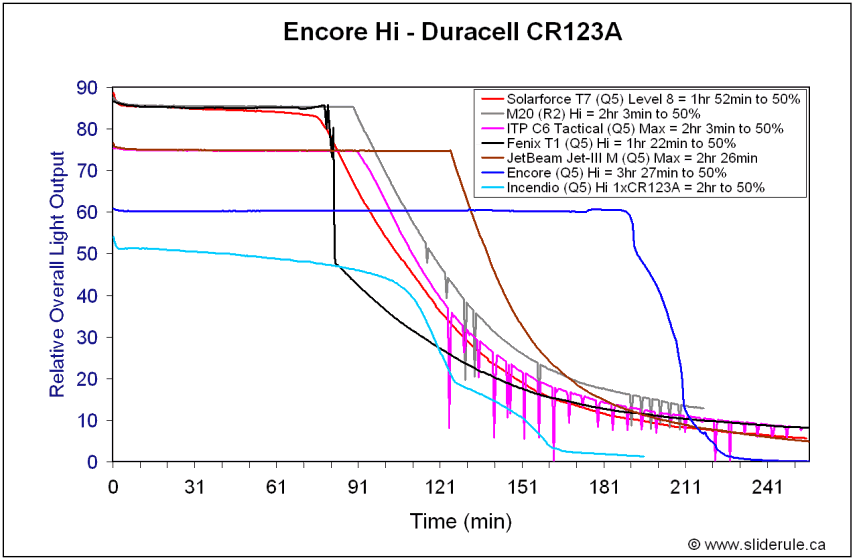
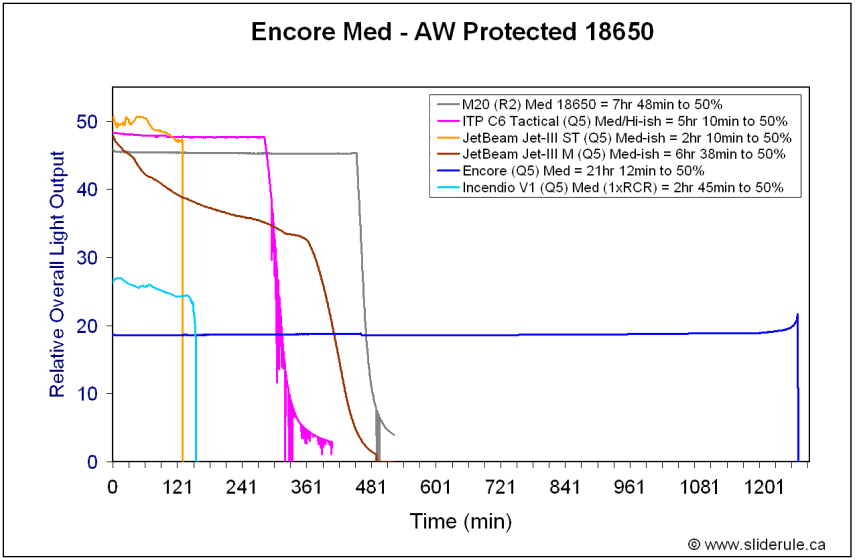
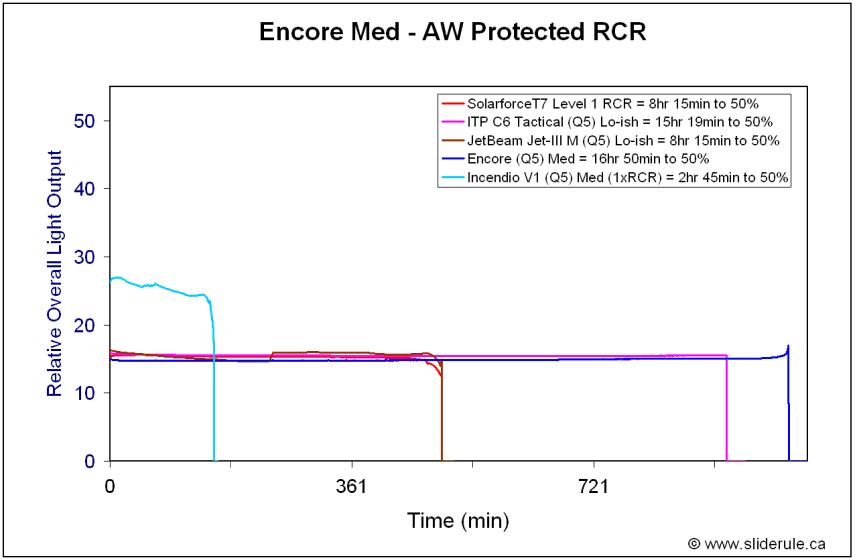
Preliminary Output/runtime Observations:
Potential Issues
The Encore body tube feels lighter and sounds "tinnier" when tapped than either my Incendio or Connexion. To try and put some numbers on this: although the Encore body tube is 75% longer than my Incendio, body tube weight has increased by less than 60%. Accordingly, body tube thickness measures ~1.8mm on my Incendio, but seems to be around ~1.6mm on the Encore.
I believe the reason for this stems from Lumapower's (understandable) decision to want to keep the head/reflector unit the same for all 3 models, but still accommodate wider protected 18650s on the Encore. They have managed this by increasing the Encore body tube diameter overall by ~1.1mm and thinning out the wall thickness by about ~0.2mm. As it is, this wider overall body diameter gives the Encore something of a tapered look over its length, coming to a point at the head (i.e. the head opening is at least 1mm smaller than the tail opening). Presumably they didn't want to widen the body diameter any further relative to the smaller head, and thus needed to thin out the body wall thickness. :shrug:
Screw thread action of the Encore head is not as smooth as my two earlier V1 lights, and the tailcap region has sharper bits near the clip (with chipped anodizing in my case). The threads on the retaining ring also seem a bit rough. I don't know if these differences are specific to just my one sample, all Encores, or more generally to all V2 lights.
V2 vs. V1 Build Differences
Note that the Encore shares a number characteristics with the new V2 versions of the Incendio/Connexion, so I thought I'd describe the main changes from the earlier models.
Tailstanding: The V2 lights can now tailstand in the Off position (V1 lights could only tailstand when On). Although this sounds like a good idea, it means the forward clicky switch is harder to activate since it is more recessed within the body tube. A number of users complained about how hard it was to activate the switch on the original V1 lights (although I personally found it fine) – this revision will exacerbate the issue for those who find it a problem.
Accessible switch and removable clip: This is a good upgrade to the V2 lights in principle, since the switch was not accessible before (although the new design likely contributes to the more recessed switch). The debris found inside my sample may have been an anomaly, and it doesn't seem to have caused any problems (presumably just shredded bits of the foam spacers). Inclusion of the black switch cover is a bonus, since not everyone likes GITD.
Reverse-battery Protection: Sounds like a good idea, but this is done in an entirely mechanical fashion by adding a raised lip on the plastic disc surrounding the contact point in the head. That means you cannot run flat-top 18650 cells (i.e. only the new button-top cells will work). To use older cells, you would need to use a small magnet (not recommended, unless krazy-glued in place), or disable this protection by filing down the lip or removing the plastic disc altogether. :sigh:
Interface: The V2 memory time has been reduced from 2 secs to 1 sec, so you don't need to worry as much about the light advancing to the next state upon a quick flash. However, sequence Hi-Med-Lo remains unchanged (personally, I think Lo-Med-Hi makes more sense for an EDC light).
Anodizing: I believe the other members of the EDC series still only have type anodizing, but Lumapower claims type III (HA) for the Encore.
Preliminary Discussion:
As readers of my original V1 Incendio review will have noticed, I am a fan of small form factor lights. In fact, I liked the Incendio so much that I went and bought a Connexion (V1) – which has an identical feel and build to my Incendio (review of that light is pending a revised 1AA round-up thread). The Encore is a thoughtful next step in the evolution of this EDC series, adding multi-power support to the smallest 18650-sized light I've ever seen.
As you can tell from above, I do have some build reservations for this new light (although those may be more general issues for the V2 series overall). That being a said, many of the positives of the V1 series haven't changed. Thanks to the shallow reflector, these lights have one of the prettiest beams I've seen for a Cree light, with only the faintest of Cree rings. The wide spill is great for an EDC light, IMO.
Regulation and output/runtime efficiency is another area where this light doesn't disappoint. I'm actually quite impressed that Lumapower has managed to produce rock-solid flat regulation while adding multipower support. It's extremely rare to find a light that is so well regulated on all battery types (i.e. 1x18650, 2xCR123A and 2xRCR) oo:. And thanks to the current-controlled circuitry, runtime performance is very good on all batteries, at all levels. :thumbsup:
oo:. And thanks to the current-controlled circuitry, runtime performance is very good on all batteries, at all levels. :thumbsup:
Personally, I think the selection of output levels makes a lot of sense for EDC (although I would prefer a Lo-Med-Hi sequence instead of the current Hi-Med-Lo). Note that maximum output is less than other lights of this class, but that's appropriate given the limited heatsinking in such a small form-factor. But the minimum output is lower than the previous V1 Incendio (which was >7 on my output scale, vs. 2.3 for the Encore) - that's impressive for a current-controlled light. I suspect these are the new levels for the V2 Incendio as well. The difference between models is thus in the runtime, size, and battery flexibility.
It has always been a pet peeve of mine to find small 2xCR123A lights that can take a single Li-ion, but are only wide enough to accept a 14670 protected cell (e.g. Fenix P3D, Olight T20, Solarforce T7, etc. ). The Encore is the smallest 18650-sized light I've seen, yet wisely includes a wider internal diameter suitable for all protected cells.
). The Encore is the smallest 18650-sized light I've seen, yet wisely includes a wider internal diameter suitable for all protected cells.
But note that this may also be an issue for some – body tube diameter overall is increased (relative to the unchanged head), and body tube wall thickness is reduced. The wider body diameter gives the light a somewhat pointed look (i.e. the head opening is at least 1mm smaller than tail opening). But this may be an advantage as well, as the light could more easily slide into a pocket head-first without getting snagged.
In conclusion, if you are looking for the smallest possible multipower 18650-size light with excellent regulation and runtime performance on all batteries, the Encore is a strong contender – just don't expect a barn-burner . Also, I encourage Lumapower to enhance the build features of this series (e.g. improved clicky feel, smoother screw threads, etc.).
. Also, I encourage Lumapower to enhance the build features of this series (e.g. improved clicky feel, smoother screw threads, etc.).
As always, I recommend potential buyers carefully read over the points above to insure you understand what you are getting. This is not a "tactical" light designed for rugged use and maximal output, but rather an attempt to make the smallest possible 18650-sized light with great battery flexibility and consistency for EDC use.
UPDATE April 5, 2009: Lumapower has released a TurboForce head for their Encore and Connexion lights, offering greater throw than the standard shallow reflector on these models. I have have provided pics below.
This light is Lumapower's newest offering in the small EDC (every day carry) space, following up on the 1xRCR/CR123A Incendio and 1xAA/14500 Connexion. The Encore uses a similar build, but can take 1x18650, 2xRCR or 2xCR123A. All three lights share a similarly sized head/reflector, and similar build features.
Note that all members of the Lumapower EDC line have recently undergone a revision. See the end of my review for a discussion of the differences between the new V2 versions (including the Encore) and the earlier V1 Incendio/Connexion.

As you can see, the light comes with an attached built-in clip (now removable), extra o-rings and GITD tailcap button, instruction manual, warranty card, and a pair of tweezers (to allow you to unscrew the switch retaining ring). The tweezers are similar to the ones you'd find on the deal sites - not very high quality, but are a nice touch to include.
For scale reference, below is a pic of the Encore and the first generation Incendio and Connexion lights, with their respective batteries.

Scroll down for a comparison pic to other members in the 1x18650 class.
Overall length: 114.9mm
Width: 21.6mm (tail), 20.5mm (head)
Battery tube wall thickness: ~1.6mm
Weight: 42.5g (without battery)


The other EDC series of lights from Lumapower only have type II black anodizing, although the Encore is supposed to be hard anodized (i.e. HA, aka type III). Unfortunately, my Encore has a chip on the tail near the removable pocket clip (see below) - otherwise, anodizing was good on my sample. Lettering is clear and sharp, as with all Lumapower lights (which is among the finest lettering I've ever seen :kiss

The black disc in the head has been updated on all V2 lights to have a ridge around the battery contact point. This is the "reverse polarity protection" feature – it's entirely mechanical, as the flat-end of the battery would be prevented from touching the contact point. But this also means that none of the older flat-top 18650 batteries will work without modification (i.e. you need to use the newer button top variety). :shakehead
Like the Incendio and Connexion, screw threads are fairly limited and narrow on the Encore. Screw thread action feels a little rougher on my Encore specimen that it does on either my Incendio or Connexion. Threads are not anodized on any of these lights, so no lock-out is possible.

Tailcap is a forward clicky, covered with a black switch cover (GITD included in the package). The original V1 Incendio/Connexion came with only a GITD, so good to have the option now. Switch is recessed so that the unit can now tailstand when the light is on or off (V1 lights could only tailstand reliably when activated). As a result, I find this switch harder to activate, since your finger needs to go deeper into the light.


The head unit is basically unchanged from the Incendio/Connexion. They use the same size reflector, lens, and o-ring (which is a rather pale GITD type).

One of the new features of the V2 lights is the ability to access the tail switch and remove the clip. When I went to do this, a number of bits of black debris fell out of the light. :thinking: The o-ring was intact, so I think these are from the foam spacers placed on either side of the switch. The switch has some metal clips along its edge, and I suspect these chewed into the foam spacers when the light was assembled. Doesn't affect function, and the parts are easily accessible (although again, I found the screw threads for the retaining ring rather rough).
UPDATE April 5, 2009: Available as an upgrade to the Encore is a TurboForce head with larger reflector for more throw. Below are some comparison pics with the new reflector.





For the beamshots below, I've used the Connexion X2 with standard head as a comparator (running on 14500). Beam pattern and overall output is similar to the Encore standard head on 18650.



As you can see, the new TurboForce head has a much narrower spillbeam and much brighter hotspot. Overall output and runtimes are unaltered, as the same emitter/circuit is used (i.e. it is just the reflector assembly that is new). The summary table further down in this review has been updated below with additional lux numbers.
User Interface
- Like the Incendio/Connexion, the Encore has 3 output modes (Hi – Med – Lo), accessed in a looping sequence by soft-pressing the clicky repeatedly. To select the desired mode, simply press the switch further until the click is made, then release.
- The light has a memory mode – if you leave if it on for more than 1 sec in any given mode, it will retain that setting for the next time you click on (reduced from 2 secs on the V1 lights).
- Light has no SOS or strobe mode.
- Light is current-controlled for its low modes, so no PWM flicker. Typically, I've found that current-controlled lights are more efficient that PWM, but can't go down to as low output levels. See below for output/runtimes in the Encore's case.

From left to right, CR123A, 18650 battery, Encore, JetBeam Jet-III PRO ST, Olight T20, Romisen RC-M4, Solarforce T7. Note that the Olight T20 and Solarforce T7 cannot take 18650 or protected 17670 batteries, since the internal diameter is too narrow.
As you can see, the Encore is the smallest light of this class in my collection.

Beamshots:
Comparison taken at ~0.5 meters from a wall, to show you the different overall spill patterns. All lights are running on AW protected 18650.



As you can see, the Encore is definitely not a thrower. But the light has a very nice beam (identical to the Incendio/Connexion, since the head is the same). In fact, its one of the smoothest beams I've seen for a Cree light :kiss:. Spillbeam is wider than most lights, with a smooth transition from spot to spill.
Testing Method: All my output numbers are relative for my home-made light box setup, a la Quickbeam's FR.com method. My relative overall output numbers are typically similar to his, although generally a little lower. You can directly compare all my review graphs - i.e. an output value of "10" in one graph is the same as "10" in another.
Output, Throw and Runtime Comparisons

As you can see, the Encore is not a heavy thrower. Overall output is also not as high as the typical 18650-sized lights, but that's appropriate given the smaller body of the Encore (with its more limited heat-sinking).
Runtimes:
To allow you to compare output levels and runtimes to the original Incendio, I've added that light to my 18650-class comparisons below.





Preliminary Output/runtime Observations:
- The Encore is fully regulated on all battery types, which is very impressive for a multi-power circuit.
oo: It is even better regulated than my V1 Incendio!
- Hi-Med-Lo Output levels are remarkably consistent between the different battery types, which is again quite impressive. :thumbsup: Relative output levels are also very sensible for an EDC light, IMO.
- Runtimes are quite good, consistent with the current-controlled nature of this light.
- I haven't done Med mode on primaries yet, or the low-mode runtimes. I expect low mode runtimes to be impressively long.
Potential Issues
The Encore body tube feels lighter and sounds "tinnier" when tapped than either my Incendio or Connexion. To try and put some numbers on this: although the Encore body tube is 75% longer than my Incendio, body tube weight has increased by less than 60%. Accordingly, body tube thickness measures ~1.8mm on my Incendio, but seems to be around ~1.6mm on the Encore.
I believe the reason for this stems from Lumapower's (understandable) decision to want to keep the head/reflector unit the same for all 3 models, but still accommodate wider protected 18650s on the Encore. They have managed this by increasing the Encore body tube diameter overall by ~1.1mm and thinning out the wall thickness by about ~0.2mm. As it is, this wider overall body diameter gives the Encore something of a tapered look over its length, coming to a point at the head (i.e. the head opening is at least 1mm smaller than the tail opening). Presumably they didn't want to widen the body diameter any further relative to the smaller head, and thus needed to thin out the body wall thickness. :shrug:
Screw thread action of the Encore head is not as smooth as my two earlier V1 lights, and the tailcap region has sharper bits near the clip (with chipped anodizing in my case). The threads on the retaining ring also seem a bit rough. I don't know if these differences are specific to just my one sample, all Encores, or more generally to all V2 lights.
V2 vs. V1 Build Differences
Note that the Encore shares a number characteristics with the new V2 versions of the Incendio/Connexion, so I thought I'd describe the main changes from the earlier models.
Tailstanding: The V2 lights can now tailstand in the Off position (V1 lights could only tailstand when On). Although this sounds like a good idea, it means the forward clicky switch is harder to activate since it is more recessed within the body tube. A number of users complained about how hard it was to activate the switch on the original V1 lights (although I personally found it fine) – this revision will exacerbate the issue for those who find it a problem.
Accessible switch and removable clip: This is a good upgrade to the V2 lights in principle, since the switch was not accessible before (although the new design likely contributes to the more recessed switch). The debris found inside my sample may have been an anomaly, and it doesn't seem to have caused any problems (presumably just shredded bits of the foam spacers). Inclusion of the black switch cover is a bonus, since not everyone likes GITD.
Reverse-battery Protection: Sounds like a good idea, but this is done in an entirely mechanical fashion by adding a raised lip on the plastic disc surrounding the contact point in the head. That means you cannot run flat-top 18650 cells (i.e. only the new button-top cells will work). To use older cells, you would need to use a small magnet (not recommended, unless krazy-glued in place), or disable this protection by filing down the lip or removing the plastic disc altogether. :sigh:
Interface: The V2 memory time has been reduced from 2 secs to 1 sec, so you don't need to worry as much about the light advancing to the next state upon a quick flash. However, sequence Hi-Med-Lo remains unchanged (personally, I think Lo-Med-Hi makes more sense for an EDC light).
Anodizing: I believe the other members of the EDC series still only have type anodizing, but Lumapower claims type III (HA) for the Encore.
Preliminary Discussion:
As readers of my original V1 Incendio review will have noticed, I am a fan of small form factor lights. In fact, I liked the Incendio so much that I went and bought a Connexion (V1) – which has an identical feel and build to my Incendio (review of that light is pending a revised 1AA round-up thread). The Encore is a thoughtful next step in the evolution of this EDC series, adding multi-power support to the smallest 18650-sized light I've ever seen.
As you can tell from above, I do have some build reservations for this new light (although those may be more general issues for the V2 series overall). That being a said, many of the positives of the V1 series haven't changed. Thanks to the shallow reflector, these lights have one of the prettiest beams I've seen for a Cree light, with only the faintest of Cree rings. The wide spill is great for an EDC light, IMO.
Regulation and output/runtime efficiency is another area where this light doesn't disappoint. I'm actually quite impressed that Lumapower has managed to produce rock-solid flat regulation while adding multipower support. It's extremely rare to find a light that is so well regulated on all battery types (i.e. 1x18650, 2xCR123A and 2xRCR)
Personally, I think the selection of output levels makes a lot of sense for EDC (although I would prefer a Lo-Med-Hi sequence instead of the current Hi-Med-Lo). Note that maximum output is less than other lights of this class, but that's appropriate given the limited heatsinking in such a small form-factor. But the minimum output is lower than the previous V1 Incendio (which was >7 on my output scale, vs. 2.3 for the Encore) - that's impressive for a current-controlled light. I suspect these are the new levels for the V2 Incendio as well. The difference between models is thus in the runtime, size, and battery flexibility.
It has always been a pet peeve of mine to find small 2xCR123A lights that can take a single Li-ion, but are only wide enough to accept a 14670 protected cell (e.g. Fenix P3D, Olight T20, Solarforce T7, etc.
 ). The Encore is the smallest 18650-sized light I've seen, yet wisely includes a wider internal diameter suitable for all protected cells.
). The Encore is the smallest 18650-sized light I've seen, yet wisely includes a wider internal diameter suitable for all protected cells.But note that this may also be an issue for some – body tube diameter overall is increased (relative to the unchanged head), and body tube wall thickness is reduced. The wider body diameter gives the light a somewhat pointed look (i.e. the head opening is at least 1mm smaller than tail opening). But this may be an advantage as well, as the light could more easily slide into a pocket head-first without getting snagged.
In conclusion, if you are looking for the smallest possible multipower 18650-size light with excellent regulation and runtime performance on all batteries, the Encore is a strong contender – just don't expect a barn-burner
As always, I recommend potential buyers carefully read over the points above to insure you understand what you are getting. This is not a "tactical" light designed for rugged use and maximal output, but rather an attempt to make the smallest possible 18650-sized light with great battery flexibility and consistency for EDC use.
Last edited:


